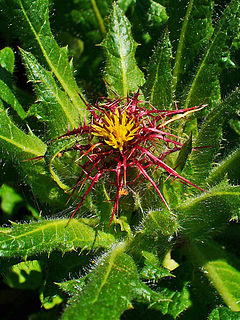Cnicus benedictus
Cnicus benedictus, the blessed thistle, is a species of phanerogam belonging to the Asteraceae/Compositae family.
- Note: the species is considered today a synonym replaced by Centaurea benedicta (L.) L., Sp. Pl.ed. 2, vol. 2, p. 1296, 1763, which is then the valid species.
Description
It is an annual plant, covered with pubescences, although devoid of thorns on the stem, hirsute, which is often procumbent. The latter is quite branched and often reddish in color, with a rounded or somewhat angular section and longitudinally striated. Up to about 60 cm tall, but usually much shorter, even nearly acaule. Conversely, in the areas where it is cultivated, it can reach a meter in height, for example in Romania. The involucre has spiny pectinated internal bracts of a dark color and more or less extended and patent to something reflexive. The exterior ones are much simpler, narrow and with only one apical spine. They are surrounded - especially in young stages of the plant - by abundant woolly lint.
The heads are solitary, surrounded by leaves; these, essentially cauline, are alternate, lobed or pinnatifid, hairy and spiny, and with the underside covered by a dense network of whitish nerves.
The florets are invariably yellow, hermaphroditic or sterile, with the anthers of the dark stamens protruding from a very thin corolla tube, measuring about 2-2.5 cm.
The fruit is a cylindrical, somewhat curved, glabrous achene, about 1 cm long, with 20 longitudinal grooves and ending in a ring with 10 teeth, separated by slits through which the external bristles of the pappus are erected.. The latter has two rows of stiff bristles, the internal short (2-5), rough and the external long (9-10mm), smooth or somewhat rough; has a remarkably developed basal lateral eleosoma
Distribution
It is native to the Mediterranean region, from Portugal and east to the Caspian Sea. In Spain it is distributed throughout practically the entire peninsular territory, particularly in the central zone and the Northeast. Introduced to eastern Australia, the eastern and western United States, and almost all of South America, as well as various countries in central and northern Europe (Belgium, Great Britain, Ireland, Germany, Russia, and Ukraine). Cultivated in Romania - where it can reach up to 1 m in height - Estonia and part of Ukraine, for medicinal purposes.
Properties
It is traditionally used as a wound disinfectant.
Active principles: contains sesquiterpene lactones of the germacranolide type: cnicin, accompanied by benedictin. Flavonoids: glycosides of apigenol, luteol and kenferol. Essential oil traces: triterpene and steroid constituents. tannins. Abundant mineral salts (10 to 20%). Traces of alkaloids, in the fruits. Other components: Bitter heteroside, volatile oil, tannin, potassium salts, resin, mucilage.
Indications: Cniccin is a bitter substance with an aperitif, eupeptic, stomachic, cholagogue, antibiotic, diuretic, febrifuge, anti-inflammatory and hypoglycemic effect; the essential oil has properties such as bacteriostatic and antifungal; flavonoids have diuretic action. It is popularly used especially for the treatment of loss of appetite and hyposecretory dyspepsia. Also in mild diabetes and states that require an increase in diuresis: genitourinary conditions (cystitis, ureteritis, urethritis, pyelonephritis, oliguria, urolithiasis), hyperazotemia, hyperuricemia, gout, arterial hypertension, edema, overweight accompanied by fluid retention. Topically in cases of herpes zoster. Formerly it was used to cure chilblains. In homeopathy, the tincture prepared from the fresh plant is used to treat hepatitis, jaundice, and against arthritis.
Contraindicated with pregnancy, lactation, children. Excessive doses can cause irritation of the digestive mucosa, with vomiting and violent diarrhea. These effects can occur even with doses of 100 to 300 mg. Given its toxicity, it is in disuse as an antipyretic. When prescribed to diabetics, blood glucose should be controlled to adjust, if necessary, the doses of insulin or oral antidiabetics.
The whole plant is used. It is harvested between June and July. Decoction: 10 g/l. Infuse 10 minutes, 1 cup before meals as an aperitif, or after, as a eupeptic. Macerated (20 g/l.), one to three cups a day.
From its medicinal «virtues», already known in remote times, it derives its specific name benedictus, blessed.
Taxonomy
Cnicus benedictus was described by Charles Linnaeus and published in Species Plantarum 2: 826. 1753.
- Cytology
- It has a number of chromosomes of 2n=22
- Etymology
Cnicus: generic name from the Greek κνεκος, and the Latin cnicos, or cnecos, the safflower, bastard saffron and other similar Thistles. In Pliny the Elder, XXI, liii, 90, as cnecon
benedictus: Latin epithet meaning "praised".
- Sinonimia
- Centaurea benedicta (L.) L.
- Cnicus benedictus var. kotschyi Boiss.
- Cnicus benedictus var. microcephalus (K.Koch) Boiss.
- Carbenia benedicta (L.) Arcang.
- Carbenia benedicta (L.) Benth.
- Cnicus bulgaricus Panov
- Centaurea benedicta (L.) L.
- Cnicus microcephalus Boiss.
- Cnicus pseudo-benedictus Hort.Dorpat. ex Asch.
- Epitrachys microcephala K.Koch p.p.
Common names
- Castilian: alcachofa, calcitrapa lanosilla, cardo, cardo blessed, cardo-huso aspero, cardo santo, centaurea blessed, centaurea sudorífica, centaurea vellosa, panicardo, tangarnina, zorrina.
Contenido relacionado
Glycolipid
Campylobacter
Carex




